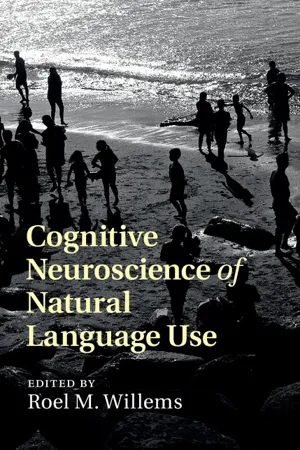
- English
- PDF
- Available on iOS & Android
Cognitive Neuroscience of Natural Language Use
About this book
When we think of everyday language use, the first things that come to mind include colloquial conversations, reading and writing e-mails, sending text messages or reading a book. But can we study the brain basis of language as we use it in our daily lives? As a topic of study, the cognitive neuroscience of language is far removed from these language-in-use examples. However, recent developments in research and technology have made studying the neural underpinnings of naturally occurring language much more feasible. In this book, a range of international experts provide a state-of-the-art overview of current approaches to making the cognitive neuroscience of language more 'natural' and closer to language use as it occurs in real life. The chapters explore topics including discourse comprehension, the study of dialogue, literature comprehension and the insights gained from looking at natural speech in neuropsychology.
Frequently asked questions
- Essential is ideal for learners and professionals who enjoy exploring a wide range of subjects. Access the Essential Library with 800,000+ trusted titles and best-sellers across business, personal growth, and the humanities. Includes unlimited reading time and Standard Read Aloud voice.
- Complete: Perfect for advanced learners and researchers needing full, unrestricted access. Unlock 1.4M+ books across hundreds of subjects, including academic and specialized titles. The Complete Plan also includes advanced features like Premium Read Aloud and Research Assistant.
Please note we cannot support devices running on iOS 13 and Android 7 or earlier. Learn more about using the app.
Information
Table of contents
- Cover
- Half-title page
- Title page
- Copyright page
- Contents
- Plates
- Figures
- Contributors
- Abbreviations
- 1 Cognitive neuroscience of natural language use: introduction
- 2 fMRI methods for studying the neurobiology of language under naturalistic conditions
- 3 Why study connected speech production?
- 4 Situation models in naturalistic comprehension
- 5 Language comprehension in rich non-linguistic contexts: combining eye-tracking and event-related brain potentials
- 6 The NOLB model: a model of the natural organization of language and the brain
- 7 Towards a neurocognitive poetics model of literary reading
- 8 Putting Broca’s region into context: fMRI evidence for a role in predictive language processing
- 9 Towards a multi-brain perspective on communication in dialogue
- 10 On the generation of shared symbols
- 11 What are naturalistic comprehension paradigms teaching us about language?
- Index
- Plates section